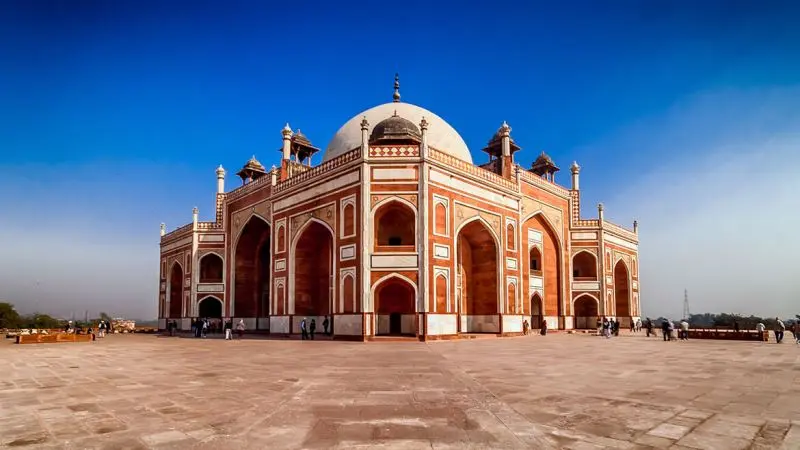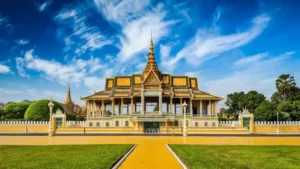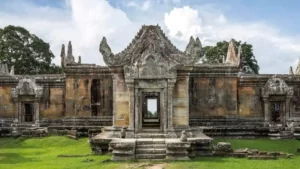Situated in the heart of Delhi, India, Humayun’s Tomb stands as an architectural masterpiece, proudly showcasing the grandeur of the Mughal era. Constructed in the mid-16th century, this magnificent mausoleum is a stunning fusion of Persian and Indian architectural styles, offering visitors a glimpse into the opulence and artistic brilliance of the Mughal dynasty.
In this article, we will explore the rich history of Humayun’s Tomb, highlight the reasons why it is a destination worth visiting, discuss its location and route, provide guidance on the best time to visit, and outline the key attractions within the complex.
History
Commissioned in 1569 by Empress Bega Begum, the widow of Emperor Humayun, Humayun’s Tomb was designed by the talented Persian architect Mirak Mirza Ghiyas. This impressive structure was erected as the final resting place for Emperor Humayun, the second Mughal ruler of India. The construction of the tomb lasted nearly nine years and served as an architectural precursor to the grandeur of the Taj Mahal.
Drawing inspiration from Persian architecture, particularly the tomb of Timur in Samarkand, Uzbekistan, Humayun’s Tomb features a captivating blend of elements. The complex boasts a majestic entrance, a charbagh (a quadrilateral garden), and a symmetrical layout with a central dome.
This architectural masterpiece marked a significant departure from the prevailing architectural styles in India, paving the way for the development of Mughal architecture.
Why Visit
Humayun’s Tomb is a destination that should not be missed by history enthusiasts, architecture aficionados, and those seeking to immerse themselves in the grandeur of Mughal heritage. Here are a few compelling reasons why a visit to Humayun’s Tomb is highly recommended:
1. Architectural Marvel
The tomb’s extraordinary architecture, blending Persian and Indian influences, showcases the exemplary craftsmanship and creativity of the Mughals.
2. Historical Significance
Humayun’s Tomb holds immense historical importance, representing the ascent of the Mughal dynasty and their profound impact on Indian culture and history.
3. Serene Ambiance
The tomb’s surroundings encompass lush green gardens, providing visitors with a serene and peaceful environment away from the bustling city.
4. Photography and Inspiration
The intricate details and symmetrical structures offer photographers a plethora of opportunities to capture stunning shots, while the elegance of the site serves as a wellspring of inspiration.
Location and Route
Humayun’s Tomb is conveniently located in Nizamuddin East, Delhi, making it easily accessible by road and public transportation. The nearest metro station is JLN Stadium, which provides connections to various parts of the city.
Upon arrival at the tomb, visitors are advised to allocate sufficient time to explore the complex and its surroundings. The route within the complex is well-marked, guiding visitors through the various structures and gardens, ensuring a comprehensive experience of the site’s magnificence.
When to Visit
For the best experience at Humayun’s Tomb, it is recommended to plan your visit during the cooler months of October to March, when the weather is pleasant. Early mornings or late afternoons are ideal to avoid large crowds and to capture the beauty of the site in the soft light.
What to See
Within the complex, several notable structures and attractions deserve attention:
1. Humayun’s Tomb
The main attraction, the tomb itself, stands as an architectural marvel with its grand dome, symmetrical design, and intricate marble lattice work.
2. Isa Khan’s Tomb
Adjacent to Humayun’s Tomb, this 16th-century tomb is dedicated to Isa Khan Niyazi, a nobleman of Sher Shah Suri’s court.
3. Arab Sarai
A historic building that previously served as an inn for pilgrims, it now houses the office of the Archaeological Survey of India.
4. Bu Halima Garden
This charming garden features well-maintained lawns, flowerbeds, and fountains, providing a serene ambiance for relaxation.
5. Nila Gumbad
A striking blue-domed structure situated within the complex, believed to be the tomb of an unknown noble.
Conclusion
Humayun’s Tomb stands as a remarkable testament to Mughal architecture and the historical legacy of Emperor Humayun. With its awe-inspiring design, serene ambiance, and significant historical importance, a visit to Humayun’s Tomb is an unforgettable experience for travelers in Delhi.
Whether you are captivated by its architectural brilliance, fascinated by its historical significance, or simply seeking tranquility amidst nature, Humayun’s Tomb offers a captivating journey into India’s rich cultural heritage.







